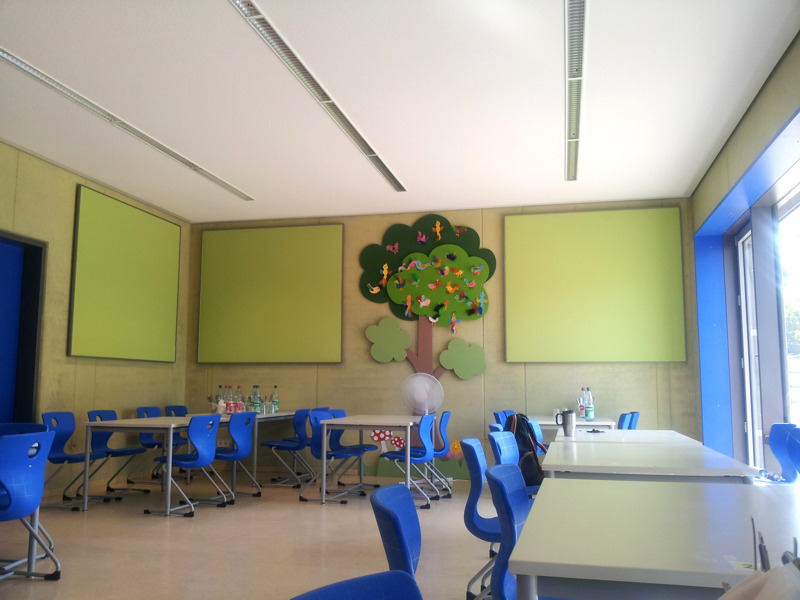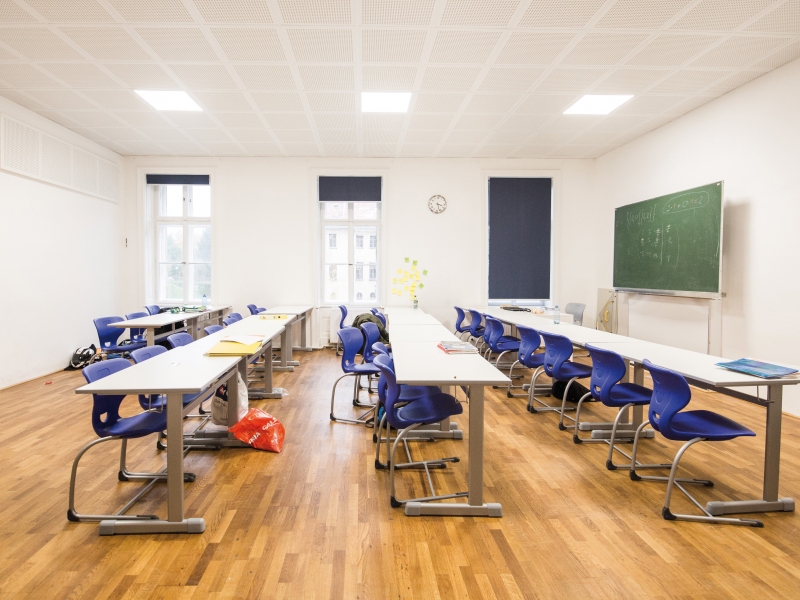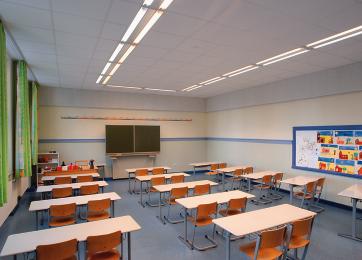Acoustic design of classrooms
1 Introduction
In classrooms, there are often high noise levels, which are perceived by
both the teachers and the students to a high degree as disturbing and
annoying.
The pupils often have problems with the speech intelligibility in
acoustically unfavorable rooms, so that they can only follow the lessons
with great effort or only partially.
This leads to rapid fatigue and impairment of performance. Based on
various studies, one can assume a deterioration in memory performance of
more than 20% [1, 2].
For teaching staff, high noise levels in the classroom may result in
stress reactions, which may occur e.g. can be detected by the heart
rate.
[3]. An acoustically unfavorable classroom also means a much greater
burden on the teacher's voice, possibly resulting in health problems.
This article describes the requirements for the acoustics in classrooms
and the measures to be recommended thereafter. As an aid to the acoustic
design of classrooms,
the IFA Room Acoustics Calculator will be presented, with which the
reverberation times can be calculated depending on the design of the
room boundary surfaces,
the furnishings of the room and the number of people in the room.

2 General basics of classroom acoustics
The noise pollution in classrooms is mainly due to the language of the
teaching staff and the students. As a rule, the language is the useful
signal,
which should arrive at all places in an intelligible way, if possible.
The language is often superimposed by a fluctuating disturbing signal,
which is caused, for example, by whispers, chairs, or external noise.
In order to understand the language well, one generally requires a
useful signal which is at least 10 dB (A) above the interference signal
(signal-to-noise ratio 10 dB).
Adults can hide the disturbing background noise relatively well and
complement incomplete acoustic information in the spirit.
However, children are less able to do so and are much more affected by
the noise than adults [1, 4, 5].
Therefore, children need a useful signal level that is about 15 dB (A)
above the noise for a faultless communication.
This is especially true for non-native speakers and for learning a
foreign language.
Assuming that an adult's voice produces a sound pressure level of 50 to
55 dB (A) during normal speech, the noise level should be as low as 35
to 40 dB (A).
In fact, the noise level in the classroom tends to be 50 dB (A), so the
teacher is forced to speak in a raised voice if he wants to be
understood by all the students.
In addition, there is the problem that the sound level of the voice
decreases over the distance and arrives in the last row - perhaps 8 m
away - significantly quieter,
while the noise behind at least as high precipitates as in the front of
the class.
For speech intelligibility, the reverberation time is of importance in
addition to the noise or background noise [4, 6]. In this case,
so-called "early sound reflections",
which strike the receiver within 50 ms of the direct sound, can
certainly contribute to a good understanding of the language [3, 7, 8].
Taking into account the speed of sound in the air of about 340 m / s, it
can be calculated that the geometric detour of the reflected sound over
the ceiling or walls
may not exceed 17 m in comparison to the direct path of the sound. The
subsequent multiply reflected sound waves (reverberation) contribute to
the fact that the information
contained in the language is smoothed and the intelligibility suffers.
Therefore, it is crucial for the acoustic quality of classrooms to avoid
the multiple reflections
of the sound at the room boundary surfaces and to limit the
reverberation times. In larger rooms, the sound can reflect several
times periodically between two parallel
wall surfaces, creating a "rasping" sound impression. One speaks then of
Flatterechos.
The reverberation in a classroom causes the teacher to speak louder to
better reach the students. But also the students behave louder in
reverberant rooms.
Especially in group work is spoken louder to make himself understood.
The resulting restlessness and the higher background noise level,
in turn, cause the speaker to speak even louder and the noise level to
increase further (Lombard effect).
As a result, the sound pressure level continues to rise and ultimately
leads to an extremely unpleasant noise exposure situation for all
affected persons.
By appropriate acoustic measures, however, the situation can be
significantly mitigated. Thus, the level-increasing sound reflections
can be significantly reduced by
a sound-absorbing design of room boundary surfaces. At the same time, a
significant improvement in speech intelligibility is achieved and speech
can be quieter again.
The mutual rocking of the different sounds described above is avoided.

3 measures
An essential basis for the acoustic design of classrooms is the standard
DIN 18041 [9], which contains room acoustic specifications and
recommendations for the
design of different rooms. The standard has been revised in recent years
in order to take greater account of the legal requirements for
barrier-free building
(inclusion) and thus the use of rooms by persons with impaired hearing.
Thereafter, classrooms the size of e.g. 250 m³ with inclusive teaching
have reverberation
times in the range of 0.4 to 0.6 s (see also [8]). Different studies
recommend even lower reverberation times of about 0.3 s for elementary
schools and preschools [10].
As a rule, the stated goals can be achieved only by a ceiling surface
with a highly absorbent material [4, 6, 11]. For this purpose, e.g.
20 mm thick sound-absorbing mineral fiber boards, if they are mounted at
least 10 cm from the ceiling (for example with the help of a rail grid).
In larger rooms, it is recommended that only the edge area of the
ceiling and possibly the upper areas of the wall surfaces be
sound-proofed,
as shown in Figure 1. Due to the sound reflections in the middle area of
the ceiling, the high-frequency sound components (consonants),
which are important for speech intelligibility, are better transmitted
to the rear of the class. For absorption of low frequencies,
the middle part of the ceiling surface can be designed as a plate
oscillator [7]. To achieve an optically uniform ceiling view,
you can dress the entire ceiling surface with a perforated or slotted
cover and deposit reflective panels in the middle of the room.
If the measures are to be implemented in-house (self-help action), foam
materials are particularly suitable (melamine resin foam panels,
flame retardant, at least fire protection class B1), which can be cut
relatively easily and simply glued to the ceiling with commercially
available adhesives [11 ].
In various rooms, wood wool lightweight panels (Heraklith) also achieved
significant improvements in room acoustics.
Particularly effective in this case should be boards in composite
construction with mineral fiber material. Curtains,
carpets and upholstered furniture also act as porous absorbers, but
especially at high frequencies, so that appropriate measures can
adversely affect the speech
intelligibility.
In addition to the sound-absorbing ceiling sound-absorbing occupancy of
the upper part of the rear wall of the room may be useful [8, 9],
as the sound reflected on the ceiling and the rear wall in the front
rows possibly arrives with too much delay against the direct sound (more
than 17 m walk)
and the intelligibility for speech thereby worsens. In addition, there
are recommendations for the realization of plate absorbers or broadband
compact absorbers,
which should be arranged on the wall surfaces or in the edges of the
room and in particular absorb the low frequencies [11, 12].
The wall behind the teacher, on the other hand, was supposed to be
reflective, in order to ensure the direct sound-supporting early
reflections.

4 room acoustics calculator for classrooms
In order to be able to test the room acoustics of classrooms in a simple
way and to develop suitable improvement measures,
the Institute for Occupational Safety of the DGUV (IFA) has created a
room acoustics computer with which the reverberation times can be
calculated and compared
with the corresponding specifications according to DIN 18041. This
program, originally developed for classrooms and group rooms of day-care
centers,
has since been extended to all rooms according to DIN 18041, in which a
good audibility (intelligibility) over medium and long distances is
required (rooms of group A).
These are in addition to the already mentioned classrooms and day care
centers, e.g. also music rooms, seminar rooms, lecture halls, meeting
rooms as well as sport
and swimming pools, whereby the DIN 18041 makes each specific
specification to the reverberation times and to the tolerances to be
kept.
To calculate the reverberation times, enter the dimensions of the room,
the type of boundary surfaces (sound absorption), the interior and the
number of students.
If the room already has a sound absorbing ceiling or corresponding wall
surfaces, these areas shall be entered with the sizes and sound
absorption characteristics.
For sound absorption, you can choose between three predefined sound
absorbers of different quality ("poor", "medium" and "good") or enter
the sound absorption levels
specified by the manufacturer for the selected material. If no
corresponding material data are available, one can refer to tables in
the literature or to the absorption
table in Annex G of DIN 18041. The sound absorption factors used for the
predefined sound absorbers as well as the corresponding values of the
self-input sound absorbers
can be viewed in a table.
After entering the required data, the reverberation times calculated for
the room are displayed in the octave bands from 125 Hz to 4000 Hz,
as shown in the example in Figure 2 for a classroom with a volume of 220
m³ and a sound-absorbing ceiling.
At the same time, the program displays the tolerance limits for
reverberation times recommended in DIN 18041, in this example for a
classroom with inclusive use.
The presented program allows a simple check of the room acoustics for
existing classrooms, the properties of existing sound absorbers e.g. can
be estimated in three stages.
For a reliable prediction of reverberation times when planning new rooms
or repairing existing rooms, however, it is advisable to reckon with the
absorptions specified by
the respective manufacturer, which are based on appropriate material
tests.
Two examples of successfully refurbished classrooms are described in my
publication "Acoustic Design of Classrooms" in Safety Engineer 6/2012
[13].
The room acoustics measures were realized within the framework of a
project "Health and learning-promoting classroom" carried out by the
German Social Accident
Insurance (DGUV). In addition to the acoustic design, other aspects of
ergonomics, e.g. to the furnishing, ventilation, lighting and color
scheme of the classroom.
5 Conclusion
The importance of room acoustics in classrooms for the well-being and
health of teaching staff may not be familiar to many school operators.
The noise situation in the class also plays a major role in the load on
the students and their performance. The room acoustic conditions in
classrooms can be
improved significantly with little effort. The reverberation times
required by DIN 18041 can generally be achieved by a sound-absorbing
ceiling design.
This relatively simple measure leads to a significantly reduced noise
level and a subjectively noticeable improvement in speech
intelligibility.
.
กก